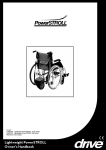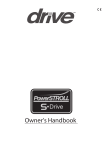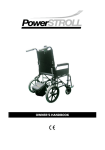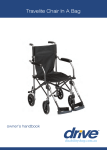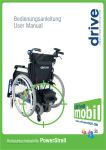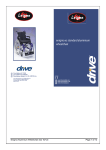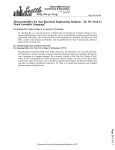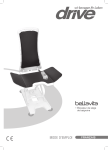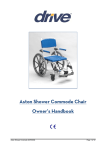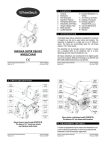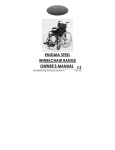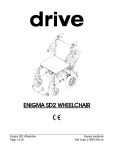Download User Manual - Amazon Web Services
Transcript
ultra lightweight aluminium wheelchair Drive Medical Ltd, Ainley’s Industrial Estate, Elland, HX5 9JP, GB www.drivemedical.co.uk contents 1. 2. 3. 4. 5. 6. 7. Contents Introduction Parts Description Leg Rest Operation Folding Back Mechanism Disassembly and Folding Using the Stepper Tube 8. 9. 10. 11. Brake Operation Operation and Propulsion Using a Lap Belt Using the Chair as a Seat in a Motor Vehicle 12. Specification 13. Warranty introduction The Enigma lightweight aluminium wheelchair is designed for occasional or frequent use, and can be used indoors and outdoors. The wheelchair is designed for a single user of up to 125kg (20 stone), depending upon the model purchased. The wheelchair is available in either a transit or self propel model. The wheelchair can be manually moved in forward and reverse and is propelled either by the wheelchair user or a carer, depending upon the model of wheelchair in use. parts description QUICK RELEASE PIN PUSH HANDLE 1/2 FOLD BACK MECHANISM ARM REST BRAKE LEVER PUSH HANDLE ARM REST SIDE PANEL SIDE PANELS 24" WHEEL & HANDRIM LEG REST FRONT CASTOR STEPPER TUBE Self Propel (LAWC007) Enigma Lightweight Aluminium Wheelchair (LAWC_IFU 12/14) 12.5" WHEEL BRAKE LEG REST FRONT CASTOR Transit (LAWC008) Page 2 of 12 leg rest adjustment For optimum comfort it is important to attain the correct leg position. The footrests have been designed so that they can be extended into one of 5 fixed positions. Unscrew the black knob on the back of the silver tubing. Adjust the legrest as required then reattach the black knob to secure. To install the leg rests, place the leg rest brackets on the pins at the side of the wheelchair frame (as shown by “1”) then swing in the leg rest (“2”) until it locks in position. Leg rests will swing in or out to reduce the length of the wheelchair. Push chrome lever whilst rotating the leg rest. To remove, simply pull up on the leg rest when swung out. 1 2 folding back mechanism 2 Push the black paddle towards the back post with your thumb (1) whilst pulling the handle down (2), as shown. Repeat this operation for the other handle. To put the backrest back into position, lift both handles together and the folding mechanism will lock back automatically. 1 Do not push down on the handles to raise the front of the wheelchair, as this could result in damage to the wheelchair. Use the stepper tube as described later in the handbook. Enigma Lightweight Aluminium Wheelchair (LAWC_IFU 12/14) Page 3 of 12 disassembly and storage This wheelchair has a number of quick release components and the wheelchair frame is easily foldable to facilitate a light carry weight and minimize storage space. 1. Quick Release Wheel. On the self propel model, the rear wheels can be removed. To remove the rear wheel, push the button in the centre of the wheel hub (shown on the diagram in grey) and slide the wheel from its axle. 2. Half Folding Back. Follow the previous instructions to fold the back. 3. Leg Rests. Follow the previous instructions to remove or swing out the leg rests. 4. Folding the wheelchair. Grab the centre of the front and rear edges of the seat sling. Pull upwards on the seat sling and the wheelchair should naturally fold up. IMPORTANT: The wheelchair is suitable as a seat in a motor vehicle. Please refer to the relevant section. Enigma Lightweight Aluminium Wheelchair (LAWC_IFU 12/14) Page 4 of 12 using the stepper tube An attendant can use the stepper tube to raise the front castors (when mounting a kerb for example). To use, push down on the stepper tube with a foot. Do not raise the front castors by pushing down on the push handles as this could result in damage to the wheelchair. To mount a kerb. Approach the kerb head on. Then the attendant uses the stepper tube to raise the front castors, and lowers the front castors on the raised kerb. Finally the attendant should push the wheelchair forward, lifting it up slightly to mount the kerb if required. To go down a kerb. Line up the front castors with the edge of the kerb. The attendant uses the stepper tube to raise the front castors and tip the user slightly back. Keeping the castors raised, slowly lower the wheelchair down the kerb. brake operation Parking Brakes To apply the parking brakes, push the handle on the brake unit until locked in place. To release the brake, push the handle in the opposite direction. The brakes should always be applied when the wheelchair is stationary. Cable Brakes On the tranist models, the attendant pushing the wheelchair may use cable-operated brakes to slow or park the wheelchair. To apply the brakes, squeeze the large lever (A) on the push handles Self Propel Only: and the brakes will be applied until the levers are released. Ensure both To lock the brakes, press the levers are pulled simultaneously to lock tab (B) forward. To release, ensure the wheelchair travels in a pull the tab (B) back. straight line. Enigma Lightweight Aluminium Wheelchair (LAWC_IFU 12/14) Page 5 of 12 operation and propulsion Before Using the Wheelchair read the safety notices below: ! Use slow speeds on gradients. Do not exceed the maximum gradient stated. The wheelchair is only suitable for single occupancy. Keep your feet on the footplates when moving. Do not stand on the footplates. Do not use escalators. Do not reverse down a gradient Maintain proper balance at all times. Users should not move their centre of gravity out of the seating area. Do not reach for items further than your arm will extend. Be aware of hazards in your environment, such as narrow doorways, steps, household appliances, children’s toys, etc. We recommend you consult your healthcare professional for advice about transferring to and from the wheelchair. The parking brakes should always be applied when transferring. Ensure that fingers and objects do not get caught in the spokes of the rear wheels. The transit wheelchair can only be propelled by an attendant. The attendant should push the wheelchair from behind using the handgrips, and following the safety advice above. The self propel wheelchair can be propelled by an attendant (as directed above) or the wheelchair user. The user can propel themselves by pushing on the handrims attached to the side of the rear wheels, and slow themselves down by applying pressure to the handrims. When stationary the brakes should always be applied. Enigma Lightweight Aluminium Wheelchair (LAWC_IFU 12/14) Page 6 of 12 using the lap belt A lap belt is to restrain the wheelchair occupant during normal use. The Ultralightweight wheelchair is suitable for use as a seat in the motor vehicle, however the lap belt should not be used. Please refer to the section of using the wheelchair as a seat in a motor vehicle. The lap belt should be adjusted to suit each user. The length of the belt can be adjusted by the tri-glides (as shown in the diagram overleaf). The lap belt has a luggage-style large locking clip to fasten and unfasten the lap belt. To fasten the lap belt, push the clip in to the receiver until it locks in the position (which can be heard by an audible click). When fastened, the lap belt should be tight around the user’s pelvis without causing discomfort or undue pressure. This will help keep the user’s hips and pelvis towards the back of the wheelchair. Use the triglides (shown) to adjust the length of the lap belt. The length of the lap belt should be checked each time the belt is used. There is a risk of suffocation from users ‘submarining’ (where they slide down the chair until the lap belt is around the neck area). To reduce the risk of this, ensure that the lap belt is used under supervision and is used as instructed. The lap belt may not be suitable for all users of wheelchairs. Seek professional medical advice before using the lap belt. Enigma Lightweight Aluminium Wheelchair (LAWC_IFU 12/14) Page 7 of 12 using the wheelchair as a seat in a motor vehicle This Enigma wheelchair has been tested to Wheelchair Crash Test standard ISO 7176/19 using restraints from Q-Straint. Wherever possible the wheelchair user should use the vehicle’s fitted seats and the wheelchair should be folded away and placed safely in the luggage compartment of the vehicle or restrained. If it is not feasible to transfer to the vehicle’s seat then the Enigma wheelchair may be used as a chair whilst the vehicle is moving with the necessary restraints and with the wheelchair facing the front of the vehicle. Drive Medical recommends that the following types of restraints be used: a) Buckle and tongue or standard hook restraints for the front of the wheelchair, b) ‘J’ restraints for the rear of the wheelchair, c) 3-point harness for the user restraint. The lap belt should be worn across the front of the pelvis, with the webbing fed between the back posts and armrest. The upper torso belt should be worn over the shoulder. The belt should be worn as firm as possible without being uncomfortable. Ensure the webbing is not twisted. For more information on restraints please contact Drive Medical. Below is a diagram illustrating the recommended positions for the restraints. The securement points for the restraints are marked on the wheelchair using the symbol (below right). 45 LEGEND Wheelchair Restraints Occupant Restraints Enigma Lightweight Aluminium Wheelchair (LAWC_IFU 12/14) Page 8 of 12 care and maintenance Before each use of the wheelchair, the brakes and tyres should be checked. The wheelchair should be stored in a dry environment, away from direct sunlight. When in storage the wheelchair can be folded up The wheelchair should be kept clean and dust free. This can be done with a duster or damp cloth. The user should routinely check the following items. It is recommended that a Drive Medical dealer services the wheelchair annually, where these items should be repaired, replaced, adjusted and/or lubricated if required: Tyre wear Wheel bearings Castors Brakes Legrest locking mechanism Seat upholstery Back upholstery Arm pads Rear wheel quick release pin Half folding back mechanism Back posts Wheelchair (folds up) powerpack installation This wheelchair is suitable for some retrofit powerpacks, such as the PowerStroll. A suggested configuration is shown left. Note this is a suggestion, and the mounting position will need adapting to be suitable for the user and the powerpack used. For more information about the PowerStroll contact your Drive Medical dealer or visit www.drivemedical.co.uk for more details. Enigma Lightweight Aluminium Wheelchair (LAWC_IFU 12/14) Page 9 of 12 specification Dimensions * 1 refers the wheelchair assembled Dimensions *2 refers to the wheelchair folded and parts removed Weight *1 is the total weight. Weight *2 is the weight without removable components We reserve the right to change designs and specifications LAWC007 and LAWC009 LAWC008 107cm x 62cm x 93cm 42” x 24.5” x 36.5” 95cm x 61cm x 97cm 37.5” x 24” x 38” 74cm x 32cm x 71cm 29” x 12.5” x 28” 65cm x 28cm x 73cm 25.5” x 11” 29” (W x D x H) 42cm x 39cm x 52cm 17” x 15.5” x 20.5” 42cm x 39cm x 52cm 17” x 15.5” x 20.5” Weight * 1 12.9kg (28lb) 11.5kg (25lb) Weight * 2 7.8kg (17lb) 10.2kg (22lb) Max User Mass 115kg / 18 stone 115kg / 18 stone Max Gradient 10º 10º LAWC011 LAWC012 109cm x 71cm x 93cm 43” x 28” x 36.5” 95cm x 66cm x 97cm 37.5” x 26” x 38” 79cm x 32cm x 73cm 31” x 12.5” x 29” 65cm x 28cm x 73cm 25.5” x 11” 29” (W x D x H) 51cm x 39cm x 52cm 20” x 15.5” x 20.5” 51cm x 39cm x 52cm 20” x 15.5” x 20.5” Weight * 1 13kg (29lb) 11.6kg (25lb) Weight * 2 8kg (18lb) 10.4kg (23lb) Max User Mass 125kg / 20 stone 125kg / 20 stone Max Gradient 10º 10º Dimensions *1 (L x W x H) Dimensions *2 (L x W x H) Seat Dimensions *1 (L x W x H) Dimensions *2 (L x W x H) Seat Enigma Lightweight Aluminium Wheelchair (LAWC_IFU 12/14) Page 10 of 12 warranty Your Drive branded product is warranted to be free of defects in materials and workmanship for one year from date of purchase. This device was built to exacting standards and carefully inspected prior to shipment. This warranty is an expression of our confidence in the materials and workmanship of our products and our assurance to the customer. In the event of a defect covered by this warranty, we will at our option supply parts or replace the device. This warranty does not cover device failure due to owner misuse or negligence, or normal wear and tear. The warranty does not extend to non-durable components, such as rubber accessories, castors and grips, which are subject to normal wear and need periodic replacement. The wheelchair frame has a 5-year warranty. If you have any queries or require full warranty conditions, please contact your Drive stockist. Drive Germany: Drive UK: Drive Medical GmbH & Co. KG Leutkircher Straße 44 D-88316 Isny/Allgäu (Germany) Drive Medical Limited Ainley’s Industrial Estate, Elland. UK WEST YORKSHIRE HX5 9JP Web www.drivemedical.de Web www.drivemedical.co.uk Enigma Lightweight Aluminium Wheelchair (LAWC_IFU 12/14) Page 11 of 12 spare parts available The following spare parts are available for your wheelchair: Z16215-01: 17” Seat canvas (grey and black) Z17480-01ST: 12.5” rear wheel Z16265-01: 17” Back canvas (grey and black) Z17527-01: RHS arm pad Z16216-01: 20” Seat canvas (grey and black) Z17577-01: LHS arm pad Z16266-01: 20” Back canvas (grey and black) Z16528-01: RHS canvas side panel Z16327-01: Push handle (Self Propel) Z16578-01: LHS canvas side panel Z16337-01: RHS push handle (transit) Z16600-01: LHS leg rest Z16338-01: LHS push handle (transit) Z16650-01: RHS leg rest Z16357-01: Half fold mechanism Z14700-01: LHS brake (for 24” wheel) Z16417-01: Castor wheel and fork Z14750-01: RHS brake (for 24” wheel) Z16451-01: Quick release pin for 24” (black cap) EB006: Brake set (for 12.5” wheel) Z16460-01ST: 24” rear wheel EB007: Brake set (for 24” wheel) The parts are available exclusively from Drive Medical stockists. To order the parts please visit the stockist where you bought the wheelchair or visit www.drivemedical.co.uk to find your local stockist. Spare part catalogues and other documentation can also be found at www.drivemedical.co.uk/technical Enigma Lightweight Aluminium Wheelchair (LAWC_IFU 12/14) Page 12 of 12












